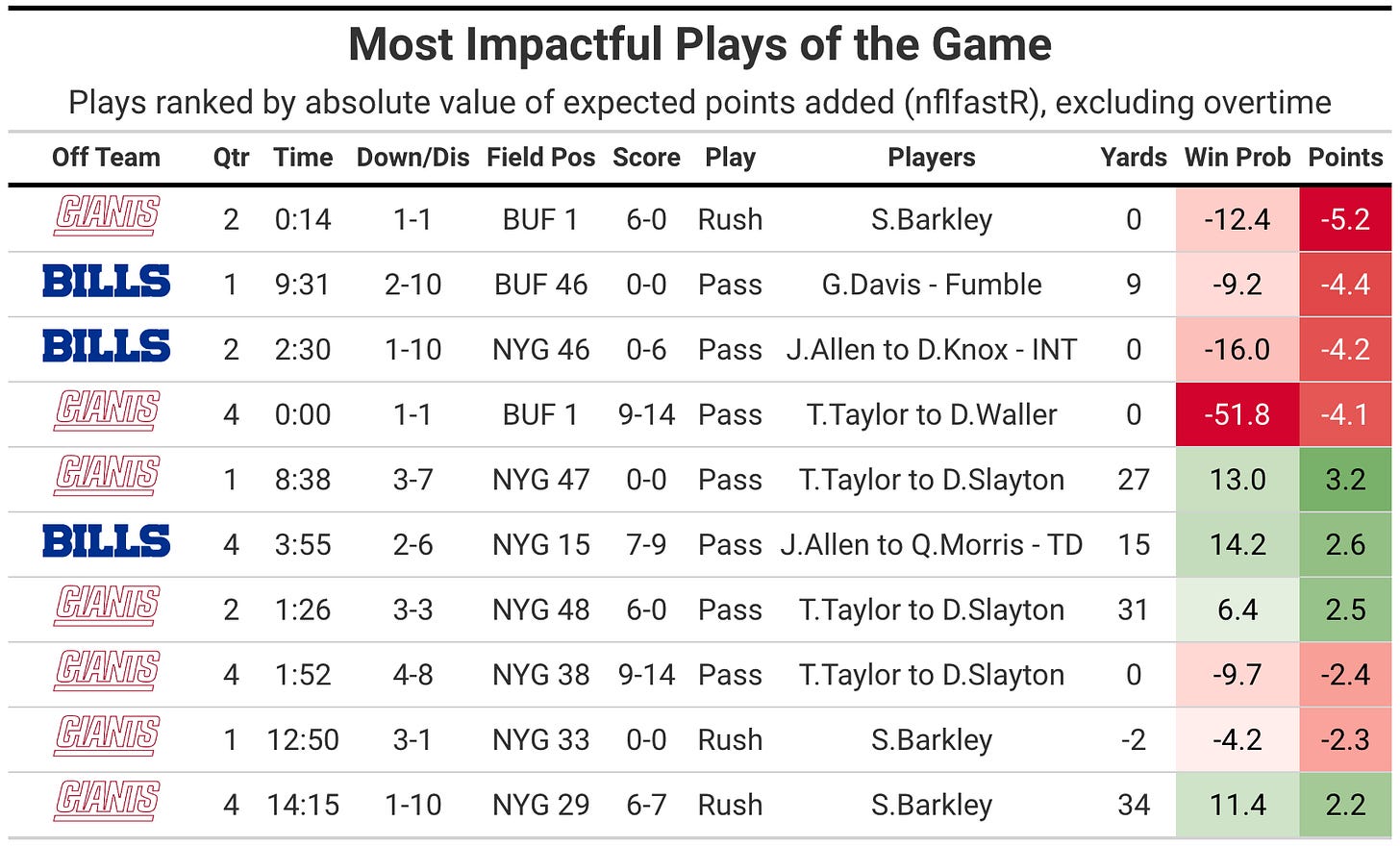Week 6, SNF Bills-Giants: Advanced Review
The Giants and Bills squeezed an entire game's worth of action into the final quarter, in an otherwise sloppy game
The adjusted scores quantify team play quality, with emphasis on stable metrics (success rate) and downplaying higher variance events (turnovers, special team, penalties, fumble luck, etc). Adjusted expected points added (EPA), in conjunction with opportunity-based metrics like total plays and drives, projects adjusted points. Adjusted scores have been tested against actual scores and offer slightly better predictive ability, though their primary benefit is explanatory.
All 2023 & 2022 and historical Adjusted Scores and other site metrics are available in a downloadable format to paid subscribers via Google Sheet.
Find previous advanced reviews here
** Adjusted Scores table:
“Pass” - Pass rate over expectation (based on context of each play and historical averages
“Success” - Success rate on offense, a key metric in adjusted score vs actual
“H & A” - Home or away team
BUF vs NYG
This was a generally sloppy game, with both offenses unable to put together big plays to put points on the board from decently good success rates. The Giants, in particular, can’t get over the line, with only three goals from five trips inside the red zone. The Giants haven’t scored an offensive touchdown since the third quarter of Week 3.
The two plays that will have the most focus coming out of the game were at the Giants’ scoreless possessions all the way down at the 1 yard-line. Both strong chances for touchdowns were ended by mistakes, one by the Giants and the other by referees.
Brian Daboll’s reaction immediately after the play and post-game comments put the blame squarely on Tyrod Taylor for checking out of a pass to run the ball with 14 seconds left in the first half from the 1 with no timeouts remaining. A pass call in that situation would have left enough time for at least one more attempt at the touchdown before settling for a field goal. If you want to play the game of everything unfolding in the exact same way with a field goal in that situation, the Giants would have been in position to win at the end with another field goal.
The question is whether Daboll’s “communication” to Taylor to “pass in that situation” was a general thing or a command given right before the play. If the latter, I see no issue with Daboll telling us what happened, and don’t think it’s throwing Taylor under the bus as others see it. If he told Taylor to start the drive or a general thing of “don’t check to a run with no timeouts” at a different time, then I agree it’s partially Daboll’s fault and he should take the public blame. The combination of the first- and second-half failures cost the Giants 9.3 expected points, and the final blame was a little bit better than a coin-toss in win probability lost (51.8% estimated).
The final play of the game appeared to be a clear holding and/or pass interference on Darren Waller, but went uncalled. On the final play of the game, there might be an argument for the run over the pass, since the game will end on a non-penalty either way, and defenses could be trained to interfere when necessary until it’s not called. The downside of a pass interference for the defense is lining up and running the same play over again. Even the best trained and unbiased referee will have trouble calling multiple, consecutive penalties on the home team with the game on the line.
The Bills’ offensive efficiency was roughly league average on the game, despite a stronger running performance by their running backs (zero designed runs for Josh Allen). Mistakes in the passing game crushed their efficiency, including a Gabe Davis fumble (-4.4 EPA) and interception targeting Dawson Knox (-4.2 EPA).
Allen’s numbers overall were okay, and getting another win is huge for his team’s chance to win the division and his individual MVP campaign. It definitely wasn’t a great performance by my amateur eye test.
Taylor’s throwing map illustrates how little upside there was in how he distributed the ball, with only five passes going more than 10 yards down the field. The map did align with higher usage for Waller and Wan’Dale Robinson, who gathered a total of 15 targets and 13 catches, though only for a total of 105 yards.








